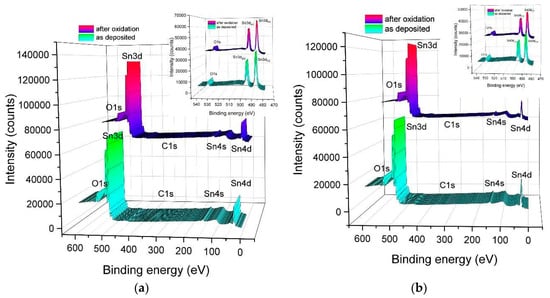Published: 19 June 2019
Aim
Within this work the advantages of Rheotaxial Growth and Vacuum Oxidation i.e. maximal extension of internal surfaces, small degree of nanograins agglomeration and reduced influence of undesired contaminations together with exceedingly well—promising features of SnO2 in terms of gas detection, have driven us to study RGVO SnO2 nanolayers for potential gas sensing applications. Moreover, the influence of doping SiO2 substrate with Cr and Al on the surface chemistry and morphology of RGVO SnO2 nanolayers is under investigation.
Results
For the purpose of the better understanding the surface chemical properties, with the special empathizes on nonstoichiometry, carbon contaminations, the relative concentrations of the main components and bondings, the XPS technique was applied. Figure 1a demonstrates XPS survey spectra with the main core level lines for RGVO SnO2 nanostructures deposited on SiO2 substrates for as deposited and additionally oxidized samples. As it can be clearly seen, the spectra contain well recognized peaks related to O1s, Sn3d, and Sn4d (basic components of the expected SnO2). The contribution of adventitious C contamination has not been detected neither in the case of raw samples nor after additional oxidation. The inset to Figure 1a shows the respective O–Sn3d spectral window required for the quantitative analysis of the surface chemistry performed in the subsequent part of the paper. In the case of RGVO SnO2 nanolayers deposited on SiO2 substrate modified with Cr and Al additives (also as deposited and after additional oxidation) the only visible XPS core level peaks also belong to the expected SnO2 compound (Figure 1b). There is no contribution from Cr nor Al that can be treated as an indirect proof of the continuous SnO2 nanolayer formation. The results of the calculation of the atomic relative concentrations [O]/[Sn] are presented in Table 1. As it can be seen, SnO2 nanolayers are highly nonstoichiometric—namely oxygen deficient. This leads to conclusion that the obtained oxides are the mixture of SnO2 with significant contribution of SnO phase which is present in both: RGVO SnO2 samples obtained on pure as well as on doped substrates. A slight increase in [O]/[Sn] can be observed each time in the case of the samples that underwent additional oxidation. Moreover the atomic relative concentration [O]/[Sn] is higher for nanolayers deposited on the substrates covered with Cr and Al.

Figure 1.
XPS survey spectra with the main core level lines of: (a) RGVO SnO2 nanolayers deposited on SiO2 substrate both as deposited and after additional oxidation, together with the corresponding O – Sn3d spectral window (in the inset); (b) RGVO SnO2 nanolayers deposited on SiO2 substrate modified with Cr and Al additives both as deposited and after additional oxidation, together with the corresponding O–Sn3d spectral window (in the inset).

Table 1.
The results of XPS investigation: relative intensity (RI) of XPS lines and the atomic relative concentrations (ARC) of the main components for RGVO SnO2 nanolayers.
Figure 2 shows the AFM data of RGVO SnO2 nanolayers containing the 3D image, average grain height distribution and the respective depth profile. As it can be seen from AFM data, that

Figure 2.
AFM data of RGVO SnO2 nanolayers including the main image, average height distribution and the layer’s edge profile.
RGVO SnO2 nanolayers exhibit the grain type surface morphology. The lateral grain dimension is in the range of 15–50 nm, whereas their height is at the level of several nm with distribution of maximum at ~5 nm, what finally causes that these nanolayers are of high flatness in a large surface area up to several µm.
Funding
This research was funded by the research grant of National Science Centre, Poland grant decision DEC-2016/20/S/ST5/00165 and partially realized within the Statutory Funding of Institute of Electronics, Silesian University of Technology, Gliwice, BK as well as BKM.
Conflicts of Interest
The authors declare no conflict of interest.
© 2019 by the authors. Licensee MDPI, Basel, Switzerland. This article is an open access article distributed under the terms and conditions of the Creative Commons Attribution (CC BY) license (https://creativecommons.org/licenses/by/4.0/).